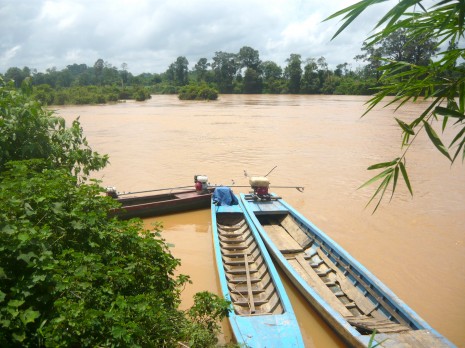The government approved the Lower Sesan 2 dam project in Stung Treng province without any prior consultation with the most affected communities in Sesan district, where at least 5,000 people stand to be displaced, rights groups and villagers said yesterday.

Located near the confluence of the Sesan and Srepok rivers in Stung Treng, the 400-megawatt dam, set to be built on one of the Mekong River’s most important tributaries, was signed off by the Council of Ministers on Friday. Among the details lacking in the announcement were the start date of the dam project and how much the villagers that stand to be displaced will be compensated.
A 2009 study showed that the dam would affect as many as 100,000 people who rely on the Sesan River in Stung Treng and Ratanakkiri provinces for fish, a major source of protein.
Meach Mean, coordinator of the 3S Rivers Protection Network, said yesterday that his organization heard nothing about the dam’s approval before Friday and was “very surprised.”
“This is a big decision from the government and I don’t want to talk anymore about the impacts,” said Mr. Mean. “I would just like them to organize a public consultation or public forum to clearly give information to all our community around the two rivers and also the local authorities.”
Mr. Mean also said that despite the mitigation measures and compensation models recommended by PECC1, the Vietnamese company that conducted the environmental impact assessment, there were still outstanding problems that he hopes will be addressed before the dam construction begins.
“They only [wrote] about the number of people who are in the reservoir site. But the reality is that from this project, [the impact] should include communities in the downstream, in the reservoir site and the upstream,” Mr. Mean said.
Om Savath, director of the Fisheries Action Coalition Team, expressed concerns about how the dam would increase pollution and affect the river’s biodiversity.
“We are concerned that the affected fisheries, biodiversity and the change of river currents will affect the fish migration, which would affect the people’s livelihoods who are living along the Sesan River,” Mr. Savath said.
A study published earlier this year by a group of international scientists said that tributary dams, most notably the Lower Sesan 2, would have “catastrophic impacts on fish productivity and biodiversity.” The scientists estimated that the Lower Sesan 2 dam would cause a 9.2 percent drop in fish stock through the entire Mekong Basin.
An older study from 2007 conducted by SWECO Groner, a research firm that works with Vietnamese state-owned power company EVN on hydropower projects, suggested that villagers, who get 90 percent of their protein from fish, could supplement their diets by raising and eating rabbits instead.
Chan Thon, 70, a village representative from Sesan district’s Srekor commune, expressed anger at the dam’s approval.
“We want the government to reconsider the relocation site and the compensation because the new site would be north of the river land, which is not good quality land,” said Mr. Thon. “It is our traditional way of living to live near the river, and if we move to the mainland, we will have no job to do.”




